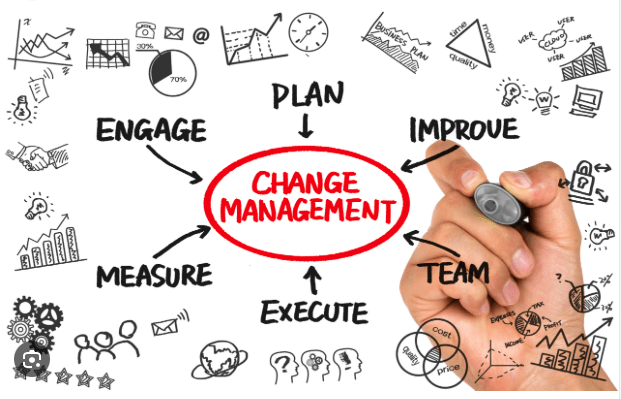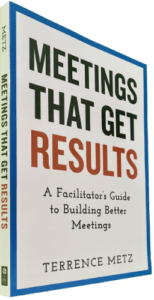Professional business facilitators confront a variety of challenges, perhaps none greater than overcoming resistance to change. Other challenges differ based on the specific context and industry. Significant and frequent facilitation challenges include:
-
Adapting to Dynamic Environments:
- Business environments are inherently dynamic and subject to constant change. Facilitators must exhibit adaptability, adjusting their approaches to diverse situations and unexpected developments. (See “Proven Methods for Managing Any and All Meeting Conflict” )
-
Communication and Misunderstandings:
- Facilitators need to navigate diverse groups with varying communication styles and perspectives, often leading to misunderstandings. Ensuring clear communication and understanding among participants remains paramount. (See “Rhetorical Precision and Clear Communications — Stress Substance Over Style”)
-
Conflict Resolution:
- Managing conflicts arising during discussions or decision-making processes is crucial. Effective conflict resolution skills are essential for maintaining a productive and collaborative environment. (See “Don’t Run! How to Manage Meeting Conflict”)
-
Facilitating Hybrid or Virtual Sessions:
- With the prevalence of remote work, facilitators encounter challenges in ensuring effective virtual meetings. They must adeptly leverage technology and devise strategies to engage participants in an online environment. (See “How to Lead Online Meetings: No Hiding and Practical Tips”)
-
Lack of Engagement:
- Participants may not uniformly engage in activities or topics. Facilitators need tools and methods to encourage participation, sustain high engagement levels, and transfer ownership of results effectively. (See “Executive Presence Strengthens Your Meeting Facilitation Skills” )
-
Maintaining Neutrality:
- Facilitators must uphold impartiality and neutrality to ensure fairness, avoiding any perception of bias. This is vital for building trust among participants. (See “How to Ensure Neutral Facilitation”)
-
Managing Large Groups:
- Facilitating large groups demands effective crowd management and ensuring all voices are heard, particularly in decision-making processes involving a diverse range of stakeholders. (See “Fun, Quick, and Effective Icebreakers for Large Groups (and Small Ones Too)”)
-
Measuring and Demonstrating Impact:
- Demonstrating the impact of facilitation efforts can be challenging. Quantifying success in terms of improved communication, decision-making, or overall team performance poses a significant hurdle. (See “How To Facilitate Vague Indicators into SMART Measures and Criteria”)
-
Resistance to Change:
- Facilitators may encounter resistance from participants who are hesitant or unwilling to embrace change. Overcoming resistance and fostering a positive attitude toward change remains a significant challenge. (See this primer that immediately follows)
Addressing these challenges requires a combination of strong interpersonal skills, adaptability, and a deep understanding of group dynamics. This article focuses on the final challenge above, a frequent and difficult challenge of facilitators—the art of overcoming resistance to change.
Guiding Change: A Facilitator’s Options for Overcoming Resistance
You might be familiar with the distinction that ‘management’ involves doing things right, while ‘leadership’ involves doing the right things. Given this perspective, shouldn’t we lean towards using the term “Change Leadership” rather than the conventional “Change Management”? The term “Change Leader” aptly captures the role of a skilled facilitator guiding purposeful and mindful change initiatives. Certainly, this viewpoint aligns with the insights of Dr. John P. Kotter.
Kotter argues that
“LEADING CHANGE must replace MANAGING CHANGE as the overriding mindset and challenge if organizations are to make it.”
Many acknowledge Kotter as a leading authority on managerial behavior and leadership responsibilities in the context of change. According to him, this isn’t a mere semantic nuance; it represents a substantial and pivotal issue.
Cultivating Transformation: Navigating Kotter’s Eight Stages of Cultural Change
Kotter scrutinized the endeavors of over 100 companies striving to transform themselves into more formidable competitors. Through this analysis, he pinpointed the prevalent errors made by leaders and managers when endeavoring to instigate change. His research yielded eight essential activities that a leader must undertake to surmount the challenges associated with change:
- Establish a Sense of Urgency
- Create a Guiding Coalition
- Develop a Vision and Strategy
- Communicate the Change Vision
- Empower Broad-Based Action
- Generate Short-Term Wins
- Consolidate Gains and Produce More Change
- Anchor New Approaches in the Culture
(see Leading Change, Harvard Business School Press)
The success of each “Leading Change” activity relies on adept facilitation to navigate cultural and individual resistance to change. Many are familiar with the FUD factor that often surrounds change initiatives: Fear, Uncertainty, and Doubt. Few professional scenarios require a neutral and reliable facilitator as much as change initiatives do. However, it’s advisable not to rely solely on the Kotter model, as there are more contemporary and potentially simpler frameworks worth considering.
Navigating Change: Unpacking the Significance of Overcoming Obstacles
Whether you label your project deliverable as Business Process Improvement (BPI), Business Process Reengineering (BPR), or any other term-du-jour, when employees sense vulnerability, it often leads to suboptimal decision-making and performance.
Process redesign entails identifying and, where possible, eliminating non-value-adding activities. Another facet involves the potential for concurrent execution of certain activities. Additionally, redesign may involve reassigning responsibility for activities to different roles or personas. This process frequently necessitates a reimagining of how a business is structured and managed and is often linked to job losses or income reduction.
Primarily credited to Michael Porter of Harvard University, the value chain models a sequence of interconnected activities. Primary activities directly contribute to the creation or production of the organization’s product or service, while secondary activities offer support to the primary ones.
The value chain is commonly employed to conceptualize the activities and tasks supported by an organization and its stakeholders. Traditionally, primary activities are categorized by functional labels such as marketing, operations, and distribution. Secondary activities typically encompass functions like legal, purchasing, research and development, and so forth.
The Enduring Legacy of Porter’s Value-Chain Methodology
Creating a value chain compels us to pinpoint the activities that contribute value to the organization and its stakeholders. Ideally, the focus should be on activities that enhance customer value rather than those that merely incur costs.
The establishment of a value chain aids in recognizing non-value-adding activities. Consequently, the outsourcing of non-value-adding activities to a third party, such as logistics, becomes feasible. However, when analyzing the simultaneous execution of activities or the reassignment of responsibilities and supporting roles, the value chain may offer less guidance. Therefore, incorporate the following considerations into your meeting designs that support change initiatives.
Innovative Approaches: Investigating Established Alternatives and Supplementary Choices to the Kotter Model
Change is an unavoidable and intricate facet of business growth. Change management models serve as guides that assist change leaders in navigating challenging transitions and directing stakeholders toward greater acceptance of adopting new methods, processes, and stakeholders.
What Constitutes a Change Management Model (or Framework)?
Change management models encompass concepts, theories, and methods designed to serve as guides in implementing and navigating transformations. Their goal is to ensure that changes are not only accepted but also effectively put into practice.
Whether the changes involve onboarding new hires, company-wide shifts in internal tools, department-specific adjustments, or anything in between, change management frameworks are crafted to facilitate smoother implementation and, crucially, to establish the change as the new norm.
“For example, switching from one video conferencing system to another may seem like an easy change. Still, anyone who has been forced to make that switch can tell you that minor frustrations such as having to hunt down the share-screen button or navigate mic-muting options can lead to a severe dislike for a new tool.” (WhatFix)
Several widely embraced management models in 2023 include:
This model focuses on the individual change experience, addressing Awareness, Desire, Knowledge, Ability, and Reinforcement as key stages in the change initiative.
Bridge’s Transition Model is a framework that focuses on managing individual transitions during times of change. It consists of three main stages: Ending, Neutral Zone, and New Beginning. The model recognizes that people experience emotional responses during change, and a successful transition involves helping them let go of the old, navigate a neutral period of adjustment, and embrace the new.
Deming’s Cycle provides a continuous improvement model that is widely used in quality management and process improvement.
Kotter’s model emphasizes the importance of creating a sense of urgency, building a guiding coalition, and anchoring the changes in the organization’s culture.
Also known as the Five Stages of Grief and introduced by psychiatrist Elisabeth Kübler-Ross provides the context of understanding the emotional responses of individuals facing terminal illness. Over time, the model has been applied to various forms of personal and organizational change. The five stages represent a series of emotional reactions that people may go through when dealing with significant transitions or losses.
Lewin’s model involves three stages: Unfreeze (preparing for change), Change (implementing the change), and Refreeze (ensuring the change becomes permanent).
Elaine Biech, building on the work of Rick Maurer, introduced the 3 Levels of Resistance and Change Model including intellectual, emotional, and operational resistance.
The McKinsey 7-S Model is a management model that identifies seven internal elements that must be aligned for an organization to be successful. The model emphasizes the interdependence of these elements and the need for alignment to achieve organizational effectiveness. The 7 S’s include:
-
- Strategy: The plan for achieving the organization’s objectives.
- Structure: The organizational design and reporting relationships.
- Systems: The processes and procedures that guide the organization’s operations.
- Skills: The capabilities and competencies of the employees.
- Staff: The organization’s workforce and their values.
- Style: The leadership and management style within the organization.
- Shared Values: The core beliefs and values that guide decision-making.
Developed by Richard Thaler and Cass Sunstein, suggests that positive reinforcement and indirect suggestions can influence the behavior and decision-making of groups or individuals. It seeks to guide choices in a way that encourages desirable outcomes without restricting options. Nudge theory often applies to areas like public policy and organizational behavior to influence decision-making and promote positive change.
The Satir Change Model, developed by family therapist Virginia Satir, describes how individuals and organizations respond to change. Its four stages include Late Status Quo, Resistance, Chaos, and Integration.
The Significance of Models for Change
Grasping the fundamental principles of widely used change management models and frameworks empowers you to apply best practices, tactics, and strategies when overseeing change projects. By relying on the core principles of change models, you can develop more effective, strategic, and context-specific change initiatives.
Change, ideally, should positively impact the bottom line. However, change initiatives can have widespread effects on productivity, revenue, customer experience, and other crucial areas. Given their intensive nature in terms of time and investment, change initiatives are inherently costly. Resistance to change is a common challenge across all models. While this article does not aim to delve into each model, it provides links to more comprehensive sources. From a facilitator’s standpoint, overcoming resistance is often a paramount concern.
Five Strategies to Conquer Resistance to Change
Explore some of the most effective approaches to address resistance to change within your organization.
-
Build stakeholders into the change management plan, placing a strong emphasis on their involvement.
-
- Frame changes with a focus on your stakeholders, especially considering that most changes involve technology. Plan with a focus on stakeholder adoption rather than solely emphasizing the technological aspects. Shift the perspective from what the technology can do to what users can achieve with the assistance of this new technology.
- Address resistance by fostering a cultural shift. Identify and train team members who naturally exhibit leadership qualities. These individuals can serve as role models and influencers, creating a ripple effect throughout the organization.
-
Empower your stakeholders throughout the transformation process.
-
- Infuse enthusiasm into your communication about the change. Clearly articulate the reasons behind it, letting your passion become infectious. Any hint of hesitation can undermine the initiative.
- Equip team members with resources, change management tools, knowledge bases, and training for the new process or tool being introduced. Diminishing uncertainty assists employees in recognizing the value of something new, fostering trust. Present concrete evidence of how the change initiative will benefit your stakeholders. Maintain continuous training efforts to ensure they feel proficient and at ease navigating the change.
- Execute your plan incrementally, allowing stakeholders to address the change one step at a time. This approach enables them to acquire new and pertinent skills gradually, making the change more digestible and less likely to be met with resistance.
-
Gather input from stakeholders continuously throughout the initiative.
-
- Frequently, employees resist change due to the perception that their opinions are disregarded and won’t influence organizational decisions. Conduct surveys among stakeholders to gauge their sentiments about the change and solicit their ideas on how to facilitate the process.
- Inclusion fosters a sense of being valued and heard. Integrate key stakeholders into the change management team to instill a feeling of ownership and accountability. Avoid making decisions without consulting those directly involved – your employees. Foster a consensus on the timeline and the strategy for managing and implementing the change initiative.
-
Offer metrics reflecting the objectives and performance of your initiative.
-
- Allow stakeholders to directly access and interpret the data, demonstrating the necessity for improvement through transparency.
- Involve various stakeholder groups when establishing OKRs, KPIs, or similar metrics that contribute to gauging success. Measurement provides organizations with insights into how the implementation impacts overall business performance. If certain aspects deviate from the plan, this offers an opportunity for prompt correction or modification during the subsequent phase of implementation.
-
Speak less and listen more.
-
- Allocate more speaking time to your stakeholders and empower them to take the lead in the conversation. People desire to be heard, so provide them with the opportunity to express their concerns and aspirations. Effective communication and connections mitigate the frustration of feeling isolated.
- The thoughts, concerns, and suggestions of stakeholders may offer valuable insights to guide your efforts. Understanding their perspectives helps pinpoint the root causes of resistance to change.
- Engaging in two-way exchanges helps construct a bridge between management and stakeholders. The more transparent and candid your communication, the less likely stakeholders are to speculate and adopt a negative outlook.
______
Don’t ruin your career by hosting bad meetings. Sign up for a workshop or send this to someone who should. MGRUSH workshops focus on meeting design and practice. Each person practices tools, methods, and activities daily during the week. Therefore, while some call this immersion, we call it the road to building high-value facilitation skills.
Our workshops also provide a superb way to earn up to 40 SEUs from the Scrum Alliance, 40 CDUs from IIBA, 40 Continuous Learning Points (CLPs) based on Federal Acquisition Certification Continuous Professional Learning Requirements using Training and Education activities, 40 Professional Development Units (PDUs) from SAVE International, as well as 4.0 CEUs for other professions. (See workshop and Reference Manual descriptions for details.)
Want a free 10-minute break timer? Sign up for our once-monthly newsletter HERE and receive a free timer along with four other of our favorite facilitation tools.
Go to the Facilitation Training Store to access proven, in-house resources, including fully annotated agendas, break timers, and templates. Finally, take a few seconds to SHARE this article with others.
To Help You Unlock Your Facilitation Potential: Experience Results-Driven Training for Maximum Impact #facilitationtraining #meeting design
______
With Bookmarks no longer a feature in WordPress, we need to append the following for your benefit and reference
- 20 Prioritization Techniques = https://foldingburritos.com/product-prioritization-techniques/
- Creativity Techniques = https://www.mycoted.com/Category:Creativity_Techniques
- Facilitation Training Calendar = https://mgrush.com/public-facilitation-training-calendar/
- Liberating Structures = http://www.liberatingstructures.com/ls-menu
- Management Methods = https://www.valuebasedmanagement.net
- Newseum = https://www.freedomforum.org/todaysfrontpages/
- People Search = https://pudding.cool/2019/05/people-map/
- Project Gutenberg = http://www.gutenberg.org/wiki/Main_Page
- Scrum Events Agendas = https://mgrush.com/blog/scrum-facilitation/
- Speed test = https://www.speedtest.net/result/8715401342
- Teleconference call = https://youtu.be/DYu_bGbZiiQ
- The Size of Space = https://neal.fun/size-of-space/
- Thiagi/ 400 ready-to-use training games = http://thiagi.net/archive/www/games.html
- Visualization methods = http://www.visual-literacy.org/periodic_table/periodic_table.html#
- Walking Gorilla = https://youtu.be/vJG698U2Mvo

Terrence Metz, president of MG RUSH Facilitation Training, was just 22-years-old and working as a Sales Engineer at Honeywell when he recognized a widespread problem—most meetings were ineffective and poorly led, wasting both time and company resources. However, he also observed meetings that worked. What set them apart? A well-prepared leader who structured the session to ensure participants contributed meaningfully and achieved clear outcomes.
Throughout his career, Metz, who earned an MBA from Kellogg (Northwestern University) experienced and also trained in various facilitation techniques. In 2004, he purchased MG RUSH where he shifted his focus toward improving established meeting designs and building a curriculum that would teach others how to lead, facilitate, and structure meetings that drive results. His expertise in training world-class facilitators led to the 2020 publication of Meetings That Get Results: A Guide to Building Better Meetings, a comprehensive resource on effectively building consensus.
Grounded in the principle that “nobody is smarter than everybody,” the book details the why, what, and how of building consensus when making decisions, planning, and solving problems. Along with a Participant’s Guide and supplemental workshops, it supports learning from foundational awareness to professional certification.
Metz’s first book, Change or Die: A Business Process Improvement Manual, tackled the challenges of process optimization. His upcoming book, Catalyst: Facilitating Innovation, focuses on meetings and workshops that don’t simply end when time runs out but conclude with actionable next steps and clear assignments—ensuring progress beyond discussions and ideas.




